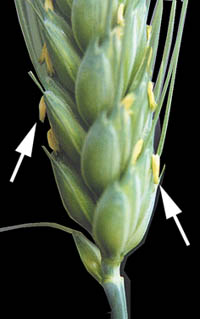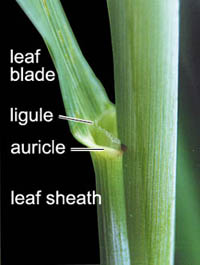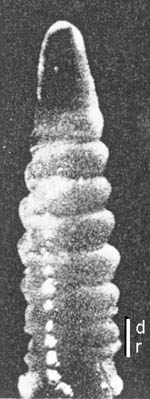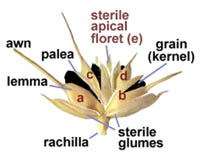Anthesis
A developmental main stage when yellow anthers are clearly visible on spikes. It is also called ‘flowering’. Each floret’s lemma and palea are forced apart by swelling of their lodicules, which allows the anthers to protrude. After a day or two, the lodicules collapse and the florets close again. In some circumstances, florets may never show the anthers. When anthers are sterile, as may occur in low-boron soils, the florets may stay open for days, or until cross-pollination occurs.
Yellow anthers

HM Rawson
Auricle
Also called a collar. It is the pale-coloured papery extension of a leaf blade at its junction with its leaf sheath. It may be slightly hairy.
Awns
These are coarse hair-like protrusions on a spike. They extend from the tip of lemmas and sometimes to a small extent on the sterile glumes. Awns photosynthesise when green.
Boot
As the young spike expands inside the leaf sheaths it can eventually be felt and finally seen after the flag leaf stage as a sheath swelling or boot. It becomes most obvious shortly before its awns start to protrude out of the top of the last sheath.
Collar
Another word for the ligule and auricle grouped together (see photo).
Conventional tillage
This involves inverting the soil surface layer, incorporating crop residues and vegetation and breaking up the surface to a fine tilth. Also called clean tillage.
Ligule and auricle locations (collar)

HM Rawson
Crusting
This is the sealing of the soil surface by fine soil particles. These particles block the larger pores, reducing the movement of gases into and from the soil, and reducing penetration of water. It is more common on soils high in silts, soils with low organic matter, and soils with high Na (sodium).
Double ridges
This is a developmental stage of the growing apex (growing point) when it is approximately 0.5 mm long. Prior to this stage the short apex (<0.2 mm) had been producing only leaf primordia or single ridges, which are angular structures. At the double ridge stage the new leaf primordia are rounded ridges and associated with each one is a bud in its axil; hence the term double ridge. This bud becomes a spikelet. A white bar is next to a double ridge in the photo.
Double ridge stage

HM Rawson
Floret
Each spikelet has between 2 and 6 florets where the grains form. Each floret is made up of a papery lemma with its long awn (both green at anthesis) and an opposing palea. These together form a cup for the grain. At anthesis each full sized lemma and palea enclose male stamens with their yellow pollen and the female stigma. Pollen falls on the stigma and self fertilization occurs to form a grain. The number of grains in a spike is equal to the number of fertile florets produced by the spike.
Green leaf area index (GLAI or LAI)
This is the area of all green leaves on a square metre of ground. When each 1 square metre of ground has more than 4 square metres of leaf growing on it (GLAI = 4) the crop is intercepting about 90% of the solar radiation falling on it (see photo on p 44). With less interception than this during stem elongation to booting stage, yields are unlikely to exceed 4 t/ha (see figure on p 45). GLAI summed over days after anthesis is called leaf area duration (LAD). Like green leaf number after heading (p 47) it is well linked to yield.
Heading
A developmental stage when the head, spike or ear emerges from its enclosing sheath. When only a small part is visible it is called ‘ear peep’. The stage from partial to full appearance is also called ‘Ear Emergence’.
Jointing stage
The stem elongates by extending the regions between the stem nodes. The first nodes (joints) become visible and progressively larger after the terminal spikelet has formed on the microscopic spike. After a crop lodges (p 49), it grows back towards the vertical by adjusting angular growth at these ‘joints’ that bear some resemblance to arthritic finger joints. The beginning of jointing is Zadoks stage Z3.0 (p 9).
Ligule
A papery structure 1 mm or so long which marks the junction between a leaf sheath and its blade and is in the same plane as the sheath (see photo associated with the collar). Together with the auricle it is called the leaf collar.
Minimum tillage
With a limited number of passes of machinery, minimum tillage aims to achieve some soil disturbance and physical weed control but to leave much of the crop residues on the surface of the soil or in the surface layers.
Pan evaporimeter
This is an aboveground circular metal trough about 1.5 m diameter and 30 cm deep and filled with water. The number of mm of water evaporated from the pan indicates approximately how much water the crop is losing, providing there is no water stress. It can be a guide to how much irrigation water needs to be applied to replace transpiration losses. You can make your own evaporimeter and measure how far the water surface falls (in mm) every few days. Top it up regularly. Make sure thirsty animals are not drinking it by covering it with chicken wire or equivalent. Your measurement is roughly how many mm of water you would have to supply to the crop to replace losses.
Perennial weeds
Plants that live for several years. The most difficult perennial weeds to control are those that propagate both by seeds and by vegetative means. Examples are the perennial grasses that can produce new plants from broken pieces of ‘root’. Broad leaved weeds such as thistles have the same approach. Both establish extensive networks of these propagating root systems.
Photosynthesis
A process used by plants to make sugars (carbohydrates) for growth. Essential ingredients in the process are solar radiation to provide energy, the green chlorophyll of the leaves and shoots to trap and convert that energy, carbon dioxide from the air to provide the carbon in the carbohydrate, and water.
Rachis
The long axis of the ear or spike to which the spikelets are attached.
Solar radiation
This is the energy from the sun that reaches the ground, remaining after passage through the atmosphere and clouds. About half that energy is visible light. Plants can use about half for photosynthesis.
Diagram of a central spikelet with 5 florets, 4 fertile and 1 under developed and sterile

HM Rawson
Spike
An alternative name for the ear or head.
Spikelet
The spike (or ear) is divided into 15 to 30 spikelets. These are in two rows up the full length of the spike (see photo on p 7). Each spikelet is made up of 2 to 6 florets where the grains form, and surrounding structures of glumes, lemmas, and paleas. These are shown on the spikelet diagram.
Spores:
These are the tiny ‘seeds’ of fungi, the means by which fungal diseases spread (p 75). Usually spores can ‘germinate’ better and infect new leaves and plants when conditions are warm and humid. A dense crop canopy is usually humid because leaves transpire.
Stem node:
A node is a junction. A stem node is where a leaf arises on the stem. Stem nodes can be felt as bumps or joints when the finger and thumb are run up the stem. Internodes are the regions between the bumps.
Stephenson Screen:
A white wooden box with angled slatted walls allowing through ventilation but no direct light, mounted about 1.5 m above the ground in which meteorological instruments are kept. It is called a screen because it screens out sunlight and rain. Instruments are usually for measuring humidity and maximum and minimum temperatures.
Sterile glumes:
Two modified leaf structures at the base of each spikelet (see spikelet diagram).
Stomata:
These are the active pores on both surfaces of leaves in wheat that, by changing their apertures, control the rate at which carbon dioxide (CO2) enters and water vapour exits the plant. They close in the dark and whenever the plant is short of water. When stomata are open, the loss of water through them cools the leaf.
Terminal (top) spikelet:
The final spikelet to be formed. This is at the top of the spike. It is produced at 90° to the plane of all other spikelets. When it appears, potential fertile spikelet number for the spike has been determined and can be counted under a microscope. In the picture there are 20 spikelets. At this stage the tiny spike is only 2 to 5 mm long but already it looks something like a spike at heading.
Terminal spikelet (TS) on a tiny spike

Tiller:
A tiller is a shoot or branch that grows from the axil (inside base) of a leaf (p 9), the point where the leaf joins its own shoot. A tiller bud is formed in the axil of every leaf but whether it grows into a tiller depends on the ‘health’ of the plant when the bud is young. It may remain dormant indefinitely if the plant is short of water when it forms. When water becomes available again, a recent tiller bud in a later axil will develop instead.
Transpiration
Leaves are covered in stomatal pores (see above). When the pores are open, water vapour leaks through them from the inside of the leaf to the air. This is called transpiration. Leakage is fastest when the stomata are most open, when the air is very dry and hot and it is windy. Under these conditions crops can lose water very quickly, at up to 1 litre per square metre of ground over three hours (assuming a closed canopy), and become stressed.
Water use efficiency (WUE)
The amount of material produced by the crop for each unit of water used. The units may be kg biomass or kg grain per kg (litre) of water. It may also be expressed as the amount of water required to produced biomass or grain. Depending on genotype, season length and evaporative conditions, crops need to transpire between 500 and 1000 litres of water throughout growth to produce each 1 kg of grain. Depending on the size of plants at anthesis and the previous factors, between 200 and 400 litres of water is needed between anthesis and maturity for each 1 kg grain. Crops with more biomass at anthesis commonly produce more grain. They have more material avail-able to move from store to the developing grains. WUE is often much poorer than these values because much of the water reaching the field does not pass through the crop. It is lost in drainage and in evaporation from bare soil early in the season. Early achievement of ground cover by the crop improves WUE.
Zero tillage
Also called direct drill. In one pass the machinery cultivates a row slot, drills the seed and places the fertilizer in the slot and covers the seed. Relatively little of the previous crop residues are disturbed or incorporated.